Above Photo: When beginning to carb count think of a turtle – slow and steady! – photo taken by Mike in Maui
This article is meant for the beginner carb counter, the recently diagnosed, or friends and family that are trying to expand their knowledge. We will start with a very basic introduction into carbohydrates, what they are and why we need them. After that we will look at what carb counting is and how to do it when cooking, eating out, and eating packaged foods. Then I will finish up we some of the tools we use to make this easier.
What is a carbohydrate?
Carbohydrates are sugars, starches, and fiber found in food. Our bodies break down these carbohydrates into energy. The rate at which they are broken down can vary based on the amount of fiber, protein, and fat that accompanies them.
Why are carbohydrates important?
I will first preface this with the assertion that there seems to be two different opinions in the T1D world regarding carbohydrates and diet. There is the low carb/no carb view, that believes in maintaining their diabetes with a diet that is very low in carbohydrates. A strong advantage of this view is, the spikes in sugar due to carbohydrates would be reduced and can result in a more leveled consistent blood sugar. The other opinion views carbohydrates as healthy part of a balanced diet and a key part of “being a kid”. Rather than eliminating carbohydrates from the diet, information about the carbohydrate (glycemic index) is used to time insulin doses, to counteract the spikes in blood sugar.
We fall under the second approach using the motto “a kid first, diabetes second”. We follow a balanced diet where carbs have their place, but our diet is also not dominated by them. We fully understand that this approach may not work for everyone and respect everyone doing what is best for their families.
Now, back to why carbohydrates are important. Carbohydrates are important for two main reasons. The first, is that carbohydrates are the most readily accessible fuel for your brain. Your body can convert a protein to a carbohydrate when no other sources are available, but this takes your body time and can be a bit more complex so I will follow up with this in a later post. The second reason, that is more important in children, is that insulin is also a growth hormone. In a type 1 diabetic, without the consumption of carbohydrates, the insulin that they get will substantially reduced. This may contributing factor to the overall smaller size that T1D’s have on average.
What is carb counting?
Carb counting is a technique used by diabetics to determine the insulin doses need for eating. The net carbohydrates are calculated for foods they will eat and then a ratio of units of insulin per gram of carbohydrates (I:C) is used to determine the dose of insulin needed.
How to Carb Count
When counting carbs the first thing that you need to know is the difference between a Total (or Gross) Carbohydrate and a Net Carbohydrate. An easy way to remember this is in terms of taxes, Gross Income is the total amount of what you were paid but the Net Income was what you actually got to take home. Similarly a Net Carbohydrate is the carbohydrate your body actually gets to use. When you see a label or advertising they are generally talking about the Total (Gross) Carbohydrates, but this may contain elements that your body can’t use as energy like fiber or sugar alcohols. These need to be subtracted from the Total (Gross) Carbohydrates to get the Net Carbohydrates.
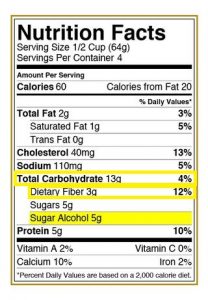
For example, with the above label, the total carbohydrate is listed as 13g. Now to get the net carbohydrates you need to subtract the fiber and sugar alcohols. 13g-(3g+5g)=5g The result is 5g of carbohydrate per 1/2 cup (64g) serving.
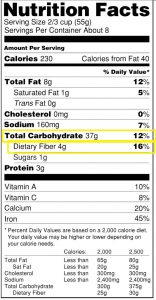
Another example, with the above label the total carbohydrate is listed as 37g. Now to get the net carbohydrates you need to subtract the fiber. 37g-4g=33g The result is 33g of carbohydrate per 2/3 cup (55g) serving.
Now what do you do if you want to eat more or less than the recommended serving? You will need to reduce the ratio to grams of carbohydrate (which is abbreviated as CHO) per g or single unit (in the case of crackers or similar products).
You will use the same formula regardless of units (ie. g, cups, tbs, unit) and remember CHO is always on top.
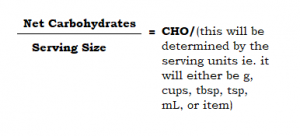
Lets try a few…
Example 1:

First determine the net carbs:
13 – (3+5) = 5CHO
Then breakdown the serving size.
First we will determine the CHO/g. You will use this if you want to weigh what you are eating – this is the most precise way to measure carbs:
5CHO / 64g = 0.078CHO/g
Now we will look at determining the CHO per cup. you will use this if you want to measure your food by volume:
5CHO / 0.5cup = 10CHO/cup
Example 2:

First determine the net carbs.
37 – 4 = 33CHO
Next we will determine the CHO/g. You will use this if you want to weigh what you are eating -again, this is the most precise way to measure carbs:
33CHO / 55g = 0.6CHO/g
When determining the number of carbs in what you are eating, you would then multiply the weight of your food in g by the CHO/g number. For example, say you wanted to eat 70g:
70g x 0.6CHO/g = 42CHO
If you want to measure your food by volume using cups you would do the following:
33CHO / 0.667cups = 22CHO/cup
When determining the number of carbs in what you are eating, you would then multiply the the volume of your food in cups by the CHO/cup number. For example, say you wanted to eat 1/4 cup:
0.25 cup x 22CHO/cup = 5.5 CHO
How to calculate the carbohydrates in an entire can or jar
Occasionally you will need to determine the number of carbs in an entire can or container. This is generally used when cooking but can also come in handy for things like soup.
Example 3:
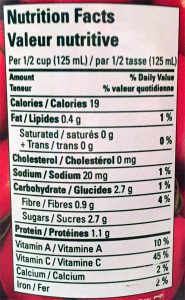
It is not noted on this label but there are 398 mL in this can.
You will first determine the net CHO per serving by subtracting the fiber from the total carbohydrates:
2.7 – 0.9 = 1.8 CHO
Then you will determine the CHO/mL by dividing the net CHO by the serving size:
1.8CHO / 125mL = 0.0144 CHO/mL
To determine the carbs for the entire can you would now multiply the CHO/mL by the total volume (mL) of the can:
0.0144 CHO/mL x 398mL = 5.73 CHO
Calculating Carbs in Condensed Products
Condensed soup is one that can be a bit tricky when you are starting out so I’ve given two examples below. The first is for making condensed soup using water and the second is using milk. NOTE when a product calls for something containing CHO to be added to it prior to serving it does not include those CHO on the nutrition label, you need to account for them yourself.
Example 4:
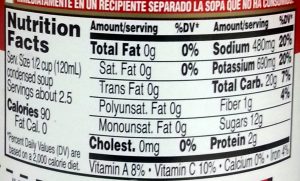
It is not noted on this label but there are 284 mL in this can.
You will first determine the net CHO per serving by subtracting the fiber from the total carbohydrates:
20 – 1 = 19 CHO
Now you know that there are 19 CHO in 125mL (1/2 cup) of condensed soup. Because you are using equal parts water and condensed soup to make your soup, and water has 0 CHO you can simply double the volume of the serving size while keeping the same number of CHO. So preparing this soup with water will result in a soup that is 19 CHO per 250mL (1 cup) serving.
Example 5:

Now let’s try it with milk. Remember there are 284 mL in this can and there are 12 CHO per 250mL (1 cup) of milk (this is the same for skim, 1%, 2%, and Homogenized).
You will first determine the net CHO per serving by subtracting the fiber from the total carbohydrates:
20 – 1 = 19 CHO
Now you will determine the CHO per mL by dividing the CHO per serving by the mL per serving:
19CHO / 125mL = 0.152CHO/mL
Next, you need to calculate the carbs in an entire can by multiplying the CHO/mL by the total volume (mL) in the can:
0.152 CHO/mL x 284mL = 43.17 CHO
You will now calculate the number of CHO of milk that you are adding. First you will determine the CHO/mL and then the CHO for the 284 mL of milk added:
12CHO / 250mL = 0.048 CHO/mL
0.048 CHO/mL x 284mL = 13.63 CHO
You will now add the CHO for the condensed soup and the milk to get the combined net carbs for the entire soup:
13.63 + 43.17 = 56.80 CHO
Now you will divide this by the total volume of soup in mL.
56.80 CHO / 568mL = 0.1 CHO/mL
0.1 mL x 250 mL = 25 CHO per 250mL (1 cup) serving.
Finding the Carb Counts for fresh food
Fresh food can be a little more daunting when starting out because it doesn’t come with a label. But don’t worry it’s easy to get the hang of. There are two ways to look at it, one is exact using weight and the other is using averages and estimating. Right now we do a little of both in our daily life, but when B was younger we had to be extremely precise in her doses. When B was diagnosed the hospital gave us a big book with the average CHO in an apple, a pepper, etc. If you would like to choose this method there are plenty of lists available through apps or with a quick Google search so I won’t elaborate any further. If you are looking for exact measurements here is how to go about it.
First you need to find the CHO/g for the item you are eating. For the purpose of this exercise let’s say a Banana. You can find this information through an app like CalorieKing or on a Google search. Depending on how the information is presented you may need to break it down further like we did in the above examples to get the CHO per g.
For example when searched a Banana comes up as 23g total carbs with 2.6g of fiber for a 100g serving of a banana.
23 – 2.6 = 20.4CHO 20.4CHO / 100g = 2.04CHO/g
You would then weigh your banana and multiply the weight by 2.04 to get the CHO for what you are eating.
This seems like and is a lot of work when you look at everything you eat in a day which is why this nutrition label scale should be in every T1D home. Please note we do not get paid anything for endorsing this scale
We love this scale because it comes with a built in nutrition label on the face and 2,000 preset foods. It is simple to use and easily allows you to calculate the carbs in anything from an apple to a bowl of ice cream. It also allows you to program in some of your favorite items. We use this feature a lot for restaurant favorites so we aren’t scrambling to looking up nutrition info on their websites as our food comes. It is sold on amazon, but the best price I’ve found is at Bed, Bath, and Beyond for $49.99. If you sign up for their emails, you will receive a 40% coupon that you can use as well!
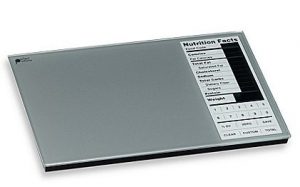
Apps like CalorieKing also allow you to enter the weight of what you are eating and they will do the calculation for you.
How to Count Carbohydrates when Cooking and Baking
Carb counting can range from the simple to the complex depending on the recipe. The below steps are a high level summary of everything that needs to be done. Due to the complexity of some recipes I will endeavor to write a post in the near future on both a baked recipe and a one pot meal.
- Measure and record everything that you put into the recipe.
- Look up the CHO counts for each item using one of the methods above.
- Add up your total CHO
- Determine the CHO per serving
- This can be done by either weighing the total recipe (i.e. weigh the pot of spaghetti sauce minus the bowl and come up with the CHO/g) or precisely measure the same amount into each serving and divide the total CHO by the number of servings (i.e. each muffin has exactly 1/4c. batter and there were 24 muffins made, you can divide the total CHO by 24

